Continuing our series on the tablets placed about Albany in celebration of the 200th anniversary of the city’s charter, this one marked the location of the first theater (or theatre, however you like to spell it) in Albany.
The tablet was described by the Bicentennial Committee as:
Bronze tablet, 16×22 inches, placed in the front wall of the original building, the present Green Street Theatre. Inscription: “First Theatre Erected in Albany Upon this Spot, 1811. First Theatrical Representation Given (place not known) by British Officers Quartered in Albany, 1760, During the French war. The First Professionals Played at the Old Hospital, Present Site of Lutheran Church, Corner of Pine and Lodge Streets, 1769.”
The building on which the tablet was placed burned in 1888 (more on that below), and it appears that the tablet safely made the journey onto the building that replaced it, but when that building was torn down in 1914, the tablet was listed as one of four that were in the custody of city authorities “by reason of alterations to or demolition of the buildings.” A new building was erected on the site, but we find no mention that the tablet made it back to its original location.
A quick forenote: throughout this piece, we will find that 19th century Albanians were not terribly fixed on whether to spell it “theater” or “theatre,” nor have we become more settled on that today. In addition, first there was a Gayety Theater, which is not the site we’re talking about today, but then there was a Gaiety Theatre, which is. There was also a Gayety Bar, at yet a third location and of undetermined relation to the theatre.
Drama Comes to Albany
There is so much misinformation about the succession of theaters that operated at this location that it’s hard to sort out names and dates. And exactly what that first theater presented by way of entertainment seems to be lost. Theater was generally not considered reputable, and theaters themselves not reputable places. H.P. Phelps, in his “Players of a Century, A Record of the Albany Stage,” (1880) identifies the Green Street Theatre as the first building constructed as a theater in Albany, and says it was initially in operation from 1810-1817.
Phelps says that theater of a sort first came to Albany in 1760, when a regiment of English soldiers “inaugurated a reign of pleasure and frivolity such as the sober Dutch town had never known before, and to cap the climax, fitted up a barn into a private theatre, and produced ‘The Beaux’ Stratagem.’” Phelps argues that English was not well understood by the residents, that few of the Dutch had ever seen a play before, and that the elders didn’t care for it.
“It was said that these wild young officers, familiar with every vice and disguise, had not only spent a whole evening in telling a gigantic lie, but they were themselves the lie! that they had violated the express commands of Scripture by appearing in women’s clothes, and above all things they had actually painted their faces!”
Dominie Freylinghausen of the Dutch Church denounced these activities from the pulpit, to which the English responded by putting on another play, which brought on more denunciation, followed by some level of outcry against the Dominie. “Believing his influence to have ceased, his sceptre to be broken, he resolved to take the hint and return to Holland.” This he did, but he never made it back home. “Whether by accident he fell into the trackless sea, or whether goaded to despair by a sense of lost popularity and usefulness, he had, in a fit of insanity, thrown himself overboard, no one ever knew . . . With the superstition for which the profession is proverbial, it is not to be wondered at that some unfortunate showmen, as they start from Albany on foot, lay their ill-luck there to the revengeful ghost of Rev. Theodorus Freylinghausen.”
That first presentation was, of course, an amateur production. Phelps says the first dramatic performance given by professionals was July 3, 1769, when an American company organized by the Hallam brothers of England came to town for an extended stay. The plays, which were allowed for one month only on Mondays, Wednesdays and Fridays, were performed in the hospital that stood on what is now Pine street. “The only play of which the title is recorded is Otway’s ‘Venice Preserved,’ with which they opened.”
The next recorded theatrical performance was noted in Charles Webster’s Albany Gazette of Dec. 5, 1785, as it was noted that once again the hospital was being fitted up as a theatre, “under the direction of the managers of the company of comedians who have entertained the inhabitants of New York for some months past with so much satisfaction to the public, and reputation to themselves. Their continuance amongst us will be but for a short time.” In that same issue of the Gazette appeared what Phelps says is probably the oldest Albany playbill in existence, which he reproduced as follows:
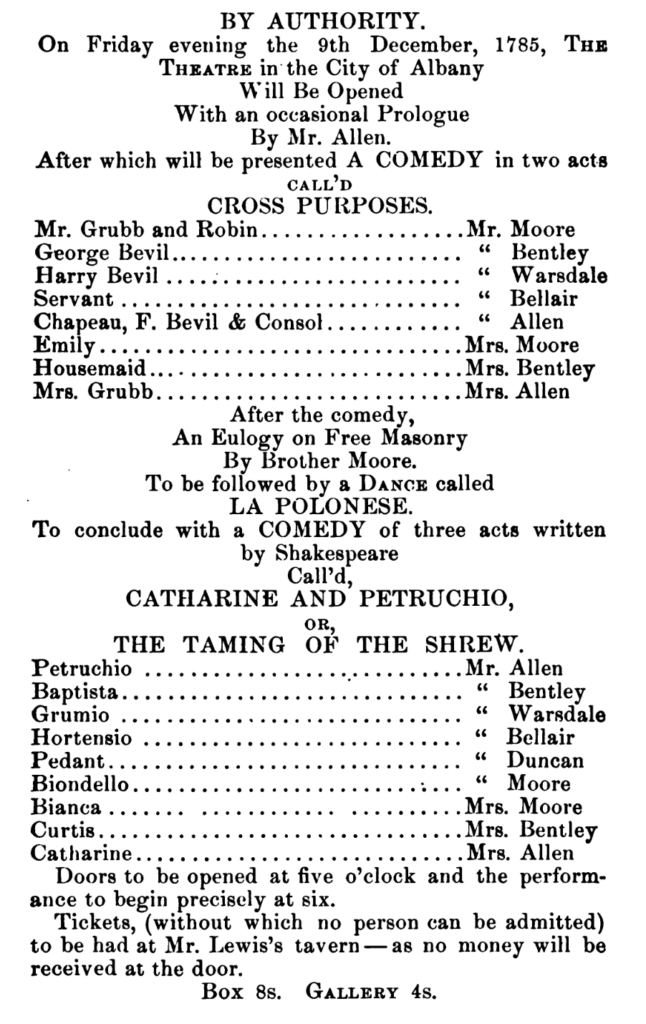
It was also noted that “Stoves are provided for the boxes, to render the house warm and comfortable.”
This announcement was greeted with a petition to the Mayor, Recorder, Aldermen and Commonalty of Albany, very strongly decrying this form of entertainment. The petitioners asked reconsideration of the authorization of the performance, and to “acquaint your citizens that the intent and meaning … was not publicly to authorize and thereby to applaud and encourage theatrical exhibitions of those persons, who, having left another more populous city pretend to stay but a short time amongst us, probably to support themselves on the way to another place, where they expect to meet with better friends and political connections; but in reality will drain us of our money, if not instill into the minds of the imprudent principles incompatible with that virtue which is the true basis of republican liberty and happiness.” And that’s how they reacted to Shakespeare, so just imagine. In any event, the petition was voted down, 9-4, and the performance went on, and it appears the comedians lived in the hospital/theater until February, when they went on to Montreal.
Phelps found no other plays presented until 1803, when again Hallam’s company presented shows three nights a week from August 22 to October 27. This time, the performances were at “the Assembly room,” a dancing hall on North Pearl near Patroon, “first called Angus’s long room, and at the time the Thespian hotel. It was a public hall used for various purposes … and finally taken down in 1835.” After that, again, there was an extended stage silence. In 1808, two royal tigers were to be seen at the Thespian hotel, if one calls that a performance, and then the first performance of “Macbeth” in Albany on April 24. In 1810, the Thespian had been renovated and plays were performed again.
An Albany theatre is built
And that takes us up to the first building constructed as a theater in Albany, known as the Albany theatre or the Green Street Theatre. Phelps says that in 1810, with a population of 10,000, “the taste for theatricals was so pronounced, that the project of building a permanent play-house was advanced, and met with much favor.” John Bernard, veteran actor and manager, came from Boston intending to open a theatre in 1811, but appears not to have followed through, appearing instead at the Thespian Hotel. A theater fire in Richmond, VA, that killed 71 people on December 26, 1811, didn’t help things along, as many saw it as the wrath of god. A resolution was passed in Albany directing the law committee to report “whether all public shows and theatrical exhibitions are not contrary to good order and morality, and, therefore ought to be discountenanced.” The report back, thought to have been written by Recorder John V.N. Yates, said there was no legal right to suppress theatrical exhibitions and that contrary to the suppositions, “a well-regulated theatre, supported by the respectable portion of society, so far from being contrary to good order and morality, must essentially contribute to correct the language, refine the taste, ameliorate the heart and enlighten the understanding.”
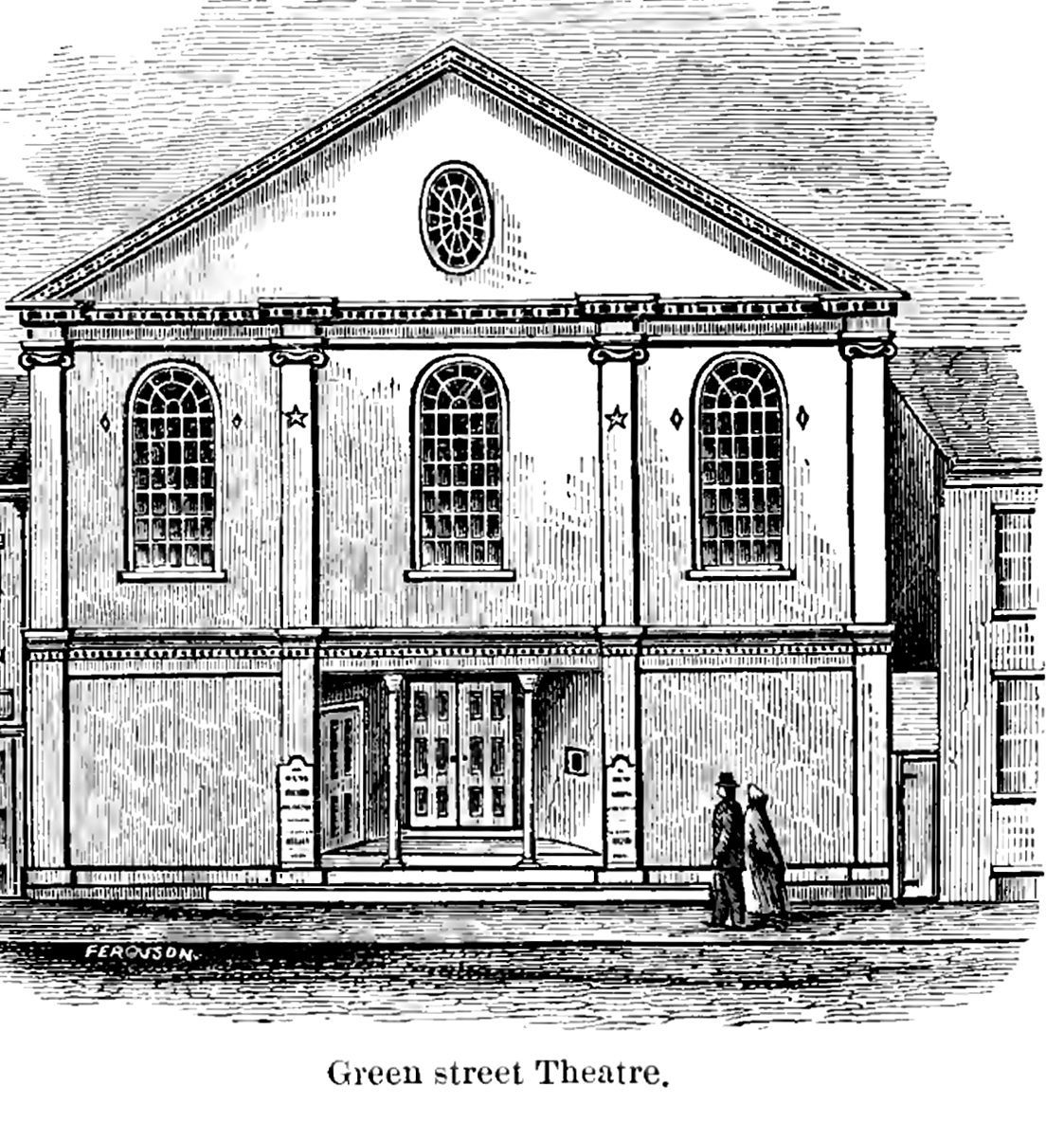
Following that, in 1812, Bernard appears to have moved forward, public solicitations were made, and during the summer of 1812 the theater on the west side of Green Street was constructed and formally opened Jan. 18, 1813. It was referred to as the Albany theatre. When Phelps was writing in 1880, the building still stood, which he called a remarkable fact. “Sooner or later a theatre burns, is the belief among insurance men, and they are justified by the records. The reason that this still exists is no doubt because it long ago closed its career as a place of amusement and became a—pork store.” Phelps described the building as brick, originally 56 by 110 feet, built by Lewis Farnham. He quoted a writer of that day as saying “The building is neat and commodious; the size and construction of the room are precisely such as they ought to be for this place. it is neither too large nor too small. it is sufficient to contain the number of auditors that will ordinarily attend, and it is so small that a whisper on the stage can be distinctly heard in every part of the room.”
What went on that first night? First an opening address by a Mr. Southey, reading the words of Solomon Southwick that began “And lo! where Hudson’s wave majestic glides, O’er fair Albania’s plains in vernal tides ….” At least it was shortish. The bill included the plays “The West Indian” and “Fortune’s Frolic.” There were shows throughout the winter, but business fell off after the river opened and its season closed June 11, 1813.
Under the same management and acting company, the Albany theatre began another season October 4, 1813, which ran through May 6, 1814. “It will be remembered that it was war times then, and business was lively. Several performances were given in honor of the American victories, and one night was set apart for the benefit of ‘poor sufferers on the lines’ who had been devastated by the British and the Indians.” There was even a short summer season. Subsequent seasons ran in 1814-15 and 1815-16; Phelps reported that the last season was not a profitable one, with few plays and few stars. A new manager came in 1817 to replace Bernard (who was still acting), “but being inexperienced, succeeded in losing all his capital in a very few weeks.”
“In June, 1818, the building having been unoccupied for a year, was sold to the Baptist society, and a subscription list circulated to raise funds for the purpose of fitting it up for church purposes. It was dedicated January 1st, 1819, (Joshua Bradley, pastor,) and for a full generation, was used as a place of worship, after which it was again made into a theatre ….”
The Baptists
According to a 1905 Albany Evening Journal article, the First Baptist Church had organized in 1811 and had “various places of worship until in the latter part of 1818 it bought the Green street theater, now the Gaiety theater, and turned that into a church . . . Among the pew holders in the Green street church was Governor, afterward President, Martin Van Buren.” (We’ll leave that fact for others to check, though it seems unlikely given that Van Buren was Kinderhook Dutch.)
Certain members of this church broke off and formed their own congregation, tearing down Vanderheyden Palace in 1833 to build their new building on North Pearl Street. This original group remained on Green Street, until they built a new church at Philip and Hudson, held their last service in the Green Street building on January 5, 1851, and left the old theater/church behind.
Return and Demise of the Green Street Theatre
The building was purchased for $6000 and altered into a theater, managed by Henry W. Preston (also known as Patrick Hoy), who had also managed the Pearl Street theatre, and who also performed on stage, as did his wife. The theater offered a mix of legitimate stage work and more popular entertainment – plays, minstrel shows, a ballet troupe, “a lot of trained monkeys,” and “Mr. Coney and his trained mastiffs.”
The sensational French opera performer Madame Julia de Marguerittes came to town on a starring tour, “and finding the Green street theatre badly mismanaged, undertook to reform things.” She undertook significant improvements that she couldn’t pay for, got into a tussle with Preston –who tried to take the place back by force, with an angry mob – and early in 1853 she left Albany for Philadelphia. “We are safe in saying that no woman ever came into Albany who created more of a sensation in so short a time, than the Madame.”
The theater reopened in March 1853 under Edmon S. Conner. Like Preston, both Conner and his wife also performed. “The Conner regime was not a pleasant one. The actors were seldom paid, and then only a dollar or so at a time. Some of them were so badly in debt for board that they had to sleep in the theatre, and eat where they could find any thing edible. The building itself was extremely damp, and Conner’s fine wardrobe was nearly ruined by storage there.”
The theater opened for another season in May 1854, and benefited somewhat in terms of talent and audience when The Museum closed in April 1855, reducing competition and giving the theater some years of stability and consistent performances. But in 1859, a new theater called the Gayety opened just up the street, on the east side of Green, two or three doors south of Beaver, and that seemed to seal the fate of the old Green Street theater. Its mortgage was foreclosed and it was sold at auction on October 10, 1859 for $28 plus incumbrances, “which amounted to more than it was worth.” There was another appearance there in November by “Blondin, the rope walker,” but the following month it was declared a nuisance by the board of health. “From this period the old Green street theatre sank out of sight, as a legitimate place of amusement.” It was then run as a concert saloon by Captain John B. Smith, presenting entertainment that Phelps did not consider part of Albany’s stage history, and so he stopped tracking the changes at the Green Street theater at that point.
The existence of that first Gayety theater often causes confusion. The Gayety on the east side of Green, at numbers 34-36, two blocks north of the Green Street theater, opened in 1859. This was a bigger house, with bigger entertainment and stars, and it coincided with the decline of the original Green Street theater into a concert saloon. It was at this Gayety theater that John Wilkes Booth performed on February 18, 1861, a relative unknown (though his father Junius Brutus Booth performed in Albany many times, and older brother J.B. Booth, Jr. was for a time the stage manager of the Nichols theater on Dallius street around 1840). He famously performed on the same night that President-elect Abraham Lincoln was in Albany, greeting the public at the Delavan Hotel. Booth, already “a violent secessionist” who had to be warned by the theater to keep his mouth shut, was staying at the Stanwix. The two did not meet, but the next night Booth met with an accident, falling on his dagger, that might have changed the course of history had the blade landed differently.
That Gayety ran through 1861, but in March 1862 reopened as a music hall, of which Phelps says “it was thereafter beneath notice in a history of the stage.” It burned in 1876, and sometime after that, the name moved down the street, under the spelling of “Gaiety,” and became affixed to the Green Street theater.
(We should note there is also frequently confusion with a Gayety Grill that was located across the street, at the corner of Hamilton. It’s entirely possible there was an association with the theater – more on the bar between the doors below.)
Proctor’s Very First Theater – The Gaiety
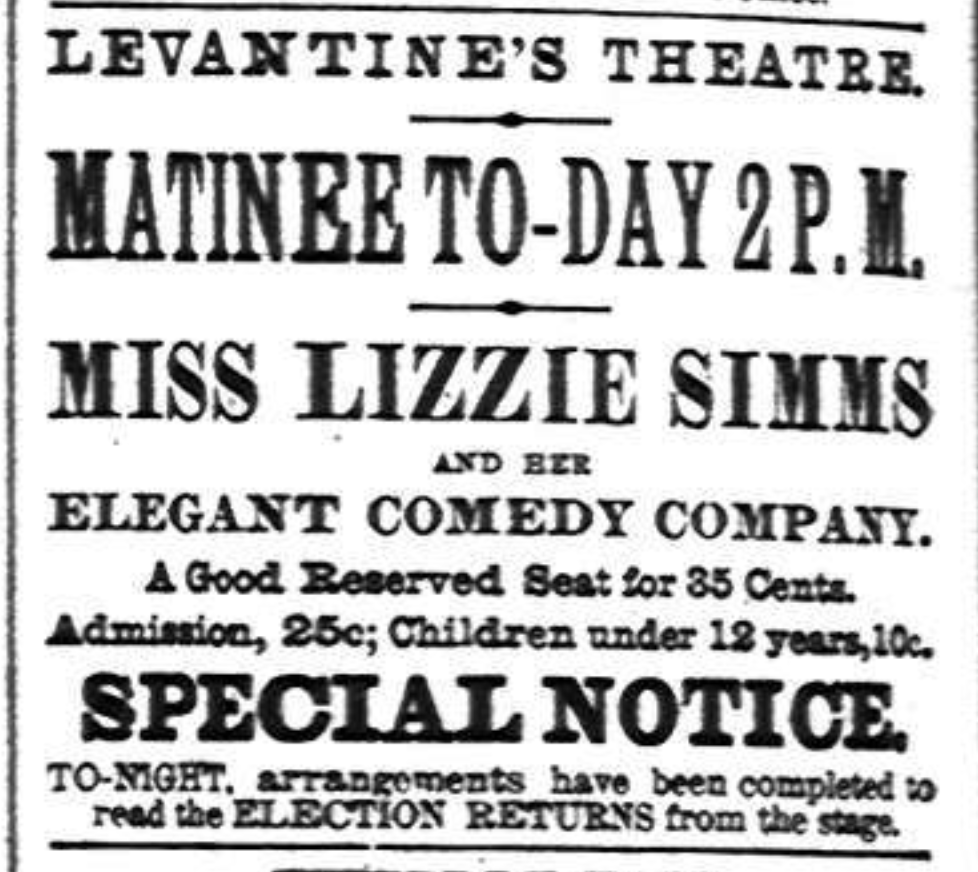
In 1884, a barrel juggler who went by the name of Fred Levantine reopened the Green Street theater under the name of the Gaiety. In keeping with tradition and necessity, both he and his wife lived in the theater, “scrubbed its floor, took tickets, sold tickets and went on the bill with their own act, which was often the best on the bill.” He was a back juggler – “that, in stage parlance, is a performer who lies on his back and juggles barrels and boxes with his feet.” He appears to have been there for a single season before going off to partner with another promoter, H.R. Jacobs, and dropping his stage name of Levantine for his real name of Proctor – Frederick F. Proctor. They opened Jacobs and Proctor’s Museum, and then Proctor went to New York to begin his ascent in the theater world. By the time he sold his business to Radio-Keith-Orpheum in 1929, Proctor was the largest individual theater circuit owner in the world. Proctor died just a month after selling his business to R-K-O, and several obituaries mentioned his start with Levantine’s Gaiety Theater on Green Street, something that appears to have since been forgotten.
The Central Theatre
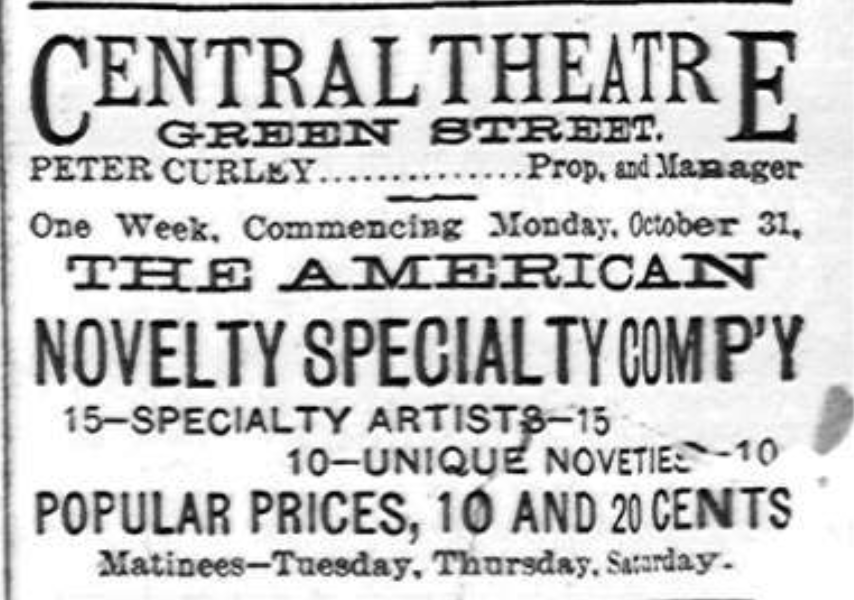
After Proctor’s departure, in September 1885 the Gaiety was advertised as the Central Theatre, presenting burlesque and minstrel shows, under the management of a Troy resident named Peter Curley. The Argus acknowledged that the theater had “such a checkered history,” but said that “it has been thoroughly overhauled and altered, and now presents an attractive appearance.” It ran under Curley’s management for several years, until April 1, 1888, when it “succumb[ed] to an almost resistless fire.”
“About 2:30 this morning an employe of the Express noticed a tongue of flame darting from a building [the theater] on Green street, and a moment later a great glaze shot skyward.” The paper said it took nearly 20 minutes before the first stream of water on the fire, and in that time “the four-story building occupied by the Albany Chemical company, adjoining on the south, and the three story building adjoining on the north, occupied by Peter Hess on the first floor as a saloon, and above as a dwelling, soon caught fire. The burning theater itself threw out intense heat and drove the plucky firemen step by step back across the street.” While the adjoining buildings were damaged, they survived, but “the theater itself was, of course, entirely gutted.” The roof and walls collapsed, and that was the end for Albany’s first purpose-built theater. But it wasn’t the end of theater at the site.
Barry’s Gaiety Theater
In the summer of 1890, Thomas Barry, “a New York theatrical man,” paired with local builder D.M. Alexander to build a new structure to be known as Barry’s Gaiety Theater. Thomas Barry, his 1909 obituary claimed, was “the first man in the world to turn a triple somersault over eight elephants, and repeat the feat, which he did daily in the Barnum & Bailey circus, where he was employed as a clown for many years. He had a tenor voice of unusual sweetness and was heard on the stage. He also gained considerable fame as a bareback rider.”
Work began on the new brick building in late June. The Morning Express wrote in July that they expected the theater to open in September 1890:
“The building is two stories high, and is to be finished inside in cherry and Norway pine. The ceilings are all to be of wood. There are two main exits opening on Green street, and a number of large windows five feet above the ground on the north side of the house, which might be used as exits in case of fire or panic. There will be a single gallery and a parquette circle underneath it. The orchestra chairs will be of cherry with an iron frame and some of them will be upholstered in leather. The stage will be 27 feet deep and 55 feet long, and the height of the proscenium arch is expected to be about 27 feet. Four boxes are to be erected and single sittings in them will be sold for a dollar. The house prices will be 15, 25, 35 and 50 cents. The new manager, Thomas Barry, was manager and proprietor last season of ‘The Two Barneys,’ a comedy sketch.”
One could easily imagine that the Albany bicentennial marker, which had been placed on the old theater just about two years before it burned, might have been lost in the fire. Whether it was saved, or replaced, isn’t clear, but it was not forgotten – the Argus wrote on July 24, 1890, that:
“Work on Barry’s Gaiety theater, which is being erected on the site of the old Green street theater, is progressing rapidly. It is to be finished in forty days. The bronze plate ‘On this site the first theater in Albany was erected, 1811’ has been placed on the front wall of the new structure between the windows.”
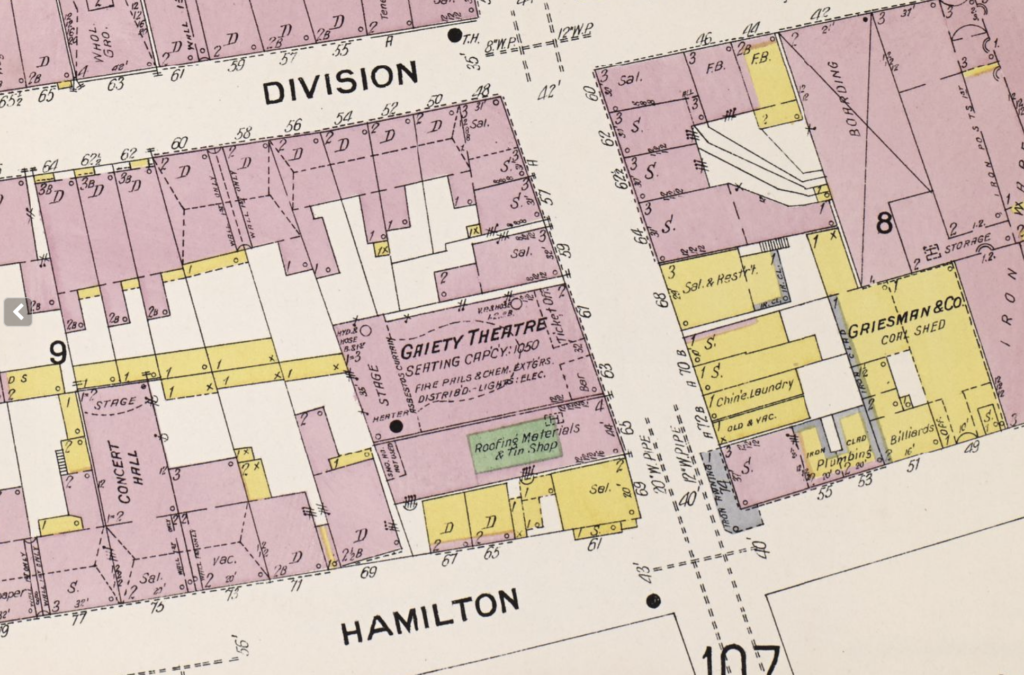
Barry and builder David Alexander bought the property from Peter and Mrs. Curley for $3000 and put $18,000 into rebuilding it. They presented, naturally, burlesque. It was in its Barry’s Gaiety incarnation that Times-Union columnist Edgard Van Olinda later (much later: 1970) wrote that the entertainment presented there
“was a thing of rough humor, never marred by subtlety, featuring a chorus that could have filled Madison Square garden with pulchritude if not with charm: the “Beef Trust” as it was frequently referred to.” He went on to say that the theater was also known as the “‘Spit Box,’ since the only safe spot to sit was under the balcony from which streams of Shield’s tobacco juice, expectorated by the denizens of the peanut gallery, gave a good imitation of the prevalent ‘April Shower.’ if the shows were sometimes dry, the member of the audience on the first floor level were not . . .”
Van Olinda also wrote that :
“Next door to the theater was [a] saloon, with a door cut between the two buildings. During the different acts, there was a constant ebb and flow of humanity with a distinct odor of Dobler’s beer on their breaths. A huge gong on the wall of the thirst parlor was rung a few minutes before curtain went up which ran a close second to the crackle of the patrons, chewing on pretzels, which, incidentally, first made their appearance in America in the oven of a local baker. Mrs. [Agnes] Barry always occupied a stage box on the second tier in order to ‘count the house’ and watch the response to the comedians’ jokes.”
In fact, Thomas Barry ran into nearly immediate controversy regarding alcohol when he opened the theater. An Albany Morning Express headline on Feb. 23, 1891, declared “This Won’t Do At All,” with the subhead “Barry Has a Bar in His Gaiety Theater on Green Street.” The Express took him to task for his opening night speech which proclaimed the theater would be first-class in every respect and highly moral in tone. Even though the paper didn’t think the Gaiety would compete with Harmanus Bleecker hall as the premiere showplace for the upper crust, “it was expected that he would not violate the law which is laid down for people who conduct theaters on Green street, just as well as for other people.”
“For a time, Mr. Barry did seem to mean to keep a nice, well-behaved place; but, either because nice, well-behaved places do not pay in that section of the city, or for some other reason, Mr. Barry became. backslider. Exhibitions of female anatomy took the place of legitimate variety shows, and the ‘paper’ with which he filled the bill-boards seemed intended as arguments to prove that ‘nature unadorned is adorned the most.’”
The Express could have forgiven the skin on display, but not the sale of alcohol from the bar that was “in the front of the building, between the two entrances. A door leads into it from the parquette directly … this is no doubt very convenient, but also very unlawful.” The police seemed to think it was fine as long as no drinks were served in the body of the theater. How this was resolved, we did not learn.
We’re not sure when Thomas Barry left the establishment, though it seems to have been long before his death in 1909. Most later remembrances in columns such as Van Olinda’s refer to the theater’s owner as Mrs. Agnes Barry – and since Thomas was still alive but not associated with the theater, we suspect a split, a suspicion soon to be reinforced.
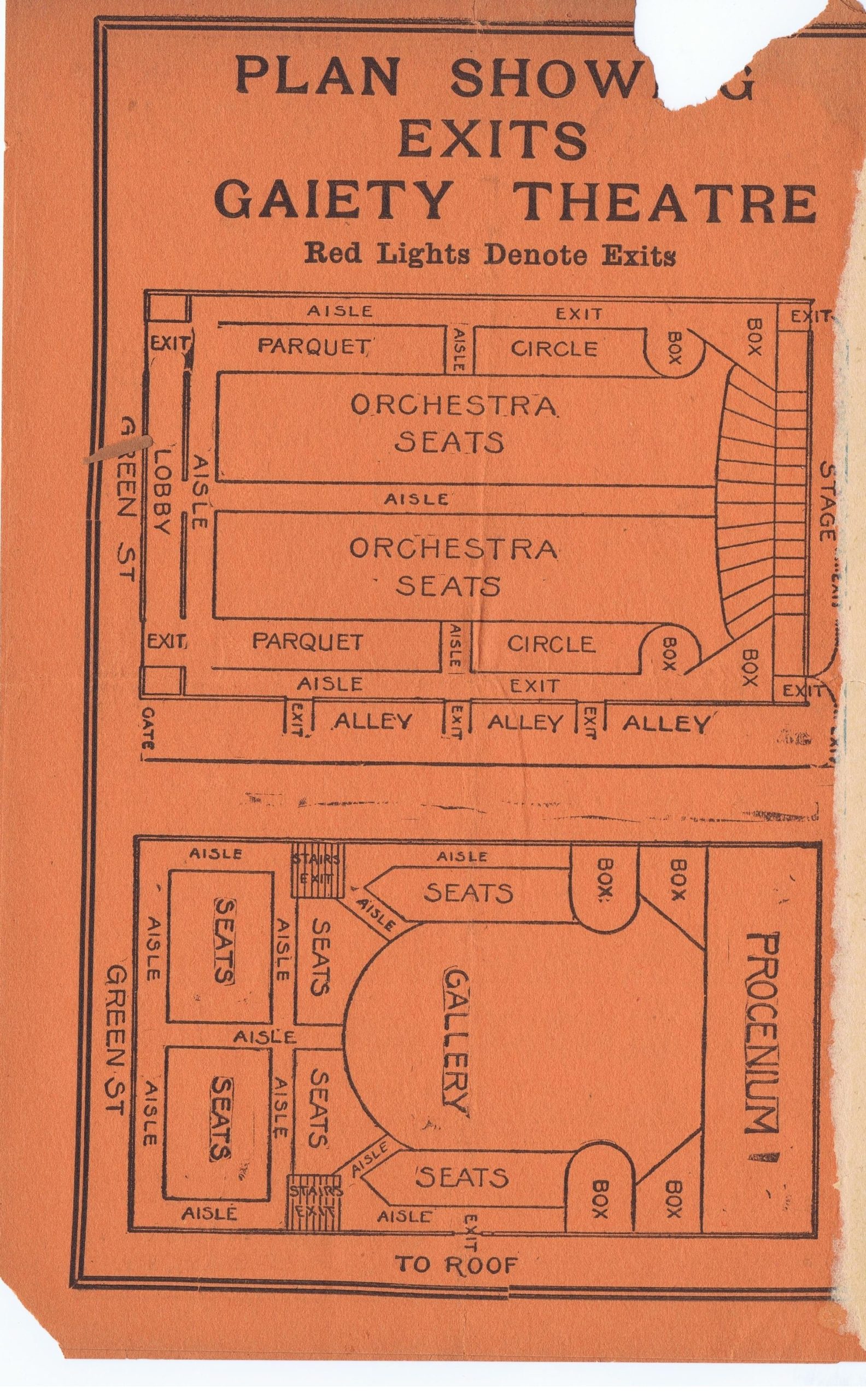
In 1903, The Gaiety was managed by Oliver H. Stacy, still showing burlesque, which it seems to have done successfully for a number of years. That came to an end in 1910, as reported in The Billboard on Oct. 20, which said that “This fall Mr. and Mrs. Howard Nichols, the managers and proprietors, found their theatre removed from the Western Wheel.” The Western Wheel was the Empire Circuit, in the days when circuits (or “syndicates”) ruled what went on in theaters coast to coast. As a performer, you got in with a touring circuit or you starved; as a theater owner, you booked with a circuit or you starved.
Billboard also provides us with this little tidbit: “Mrs. Nichols is better known as Mrs. Agnes Barry and for years she managed the Gaiety alone.”
In 1910, Agnes Barry, or perhaps Nichols, “wife of the manager of the Gaiety theater and former manager herself,” filed for bankruptcy. “Mrs. Nichols’s financial troubles began early this fall when she attempted to open the theatrical season with a burlesque stock company. For years syndicate shows have been played at the Gaiety, but Mrs. Nichols could not come to a satisfactory agreement with the syndicate this year.” When they weren’t paid, the stock company left the theater and filed suit for their salaries. “When the stock company quit, the Knickerbocker Athletic club took over the lease.”
The Knickerbocker Athletic club presented boxing matches at the theater, seemingly quite a number of them, at least through 1912, though we find advertisements for burlesque in that year as well. The Knickerbockers even showed filmed boxing matches, such as the 1912 Abe Attell-Johnny Kilbane featherweight championship. “In Syracuse the Knicks did nearly $5,000 worth of business with the pictures and their burlesque show in one week.” Interestingly, the secretary of the club was Oliver H. Stacy, who was still booking whatever shows he could to keep the theater afloat. “Ollie” Stacy stayed with boxing, and in 1955 he was appointed as a state boxing inspector. It said he had been with the Knickerbocker Athletic Club as far back as 1906; the same article notes that the club’s matches, which started in Dobler park on Second Avenue before shifting to the Gaiety, then went on to German Hall (IOOF Hall) on Beaver Street, before finishing out on North Ferry Street.
The very end of the theater
It seems like after a very busy year of boxing and more in 1912, the Gaiety finally closed its doors; we don’t find any promotions there in 1913. In January 1914, the Argus reported that it had been torn down:
“The past week marked the completion of the demolition of one of Albany’s historic buildings, the old Gaiety theatre on Green street near Hamilton street. This building was erected in 1811 [Phelps says 1812] and was the first edifice built in Albany for the purposes of a theatre. Since its erection it was several times slightly remodeled, but the front was only changed by putting in two large windows on the first story. A two-story warehouse is to be built on the site of the old Gaiety by Thomas Finklestein and others, and the old front of the first story is to be preserved as part of the new building.”

That report, indicating that the original front wall remained, runs counter to previous articles in the Argus indicating that the old Green Street theater building had been entirely replaced by the new Gaiety. So we don’t know whether some portion of the theater survived until 1914. But we do know that the bicentennial tablet survived that long, and that it was supposedly taken into custody by the city, presumably to be replaced at a later date – but we have no evidence that it ever was, and the marker appears to have last been seen in 1914.
In the theater’s place was a warehouse and business block at 61-63 Green Street. In 1916, Albany Knitting Company, which had moved up from Kinderhook (where it was Columbia Knitting Company) was at 61 Green, along with Bernard Kraft clothing. Patrick F. Hart paints occupied 63 Green.
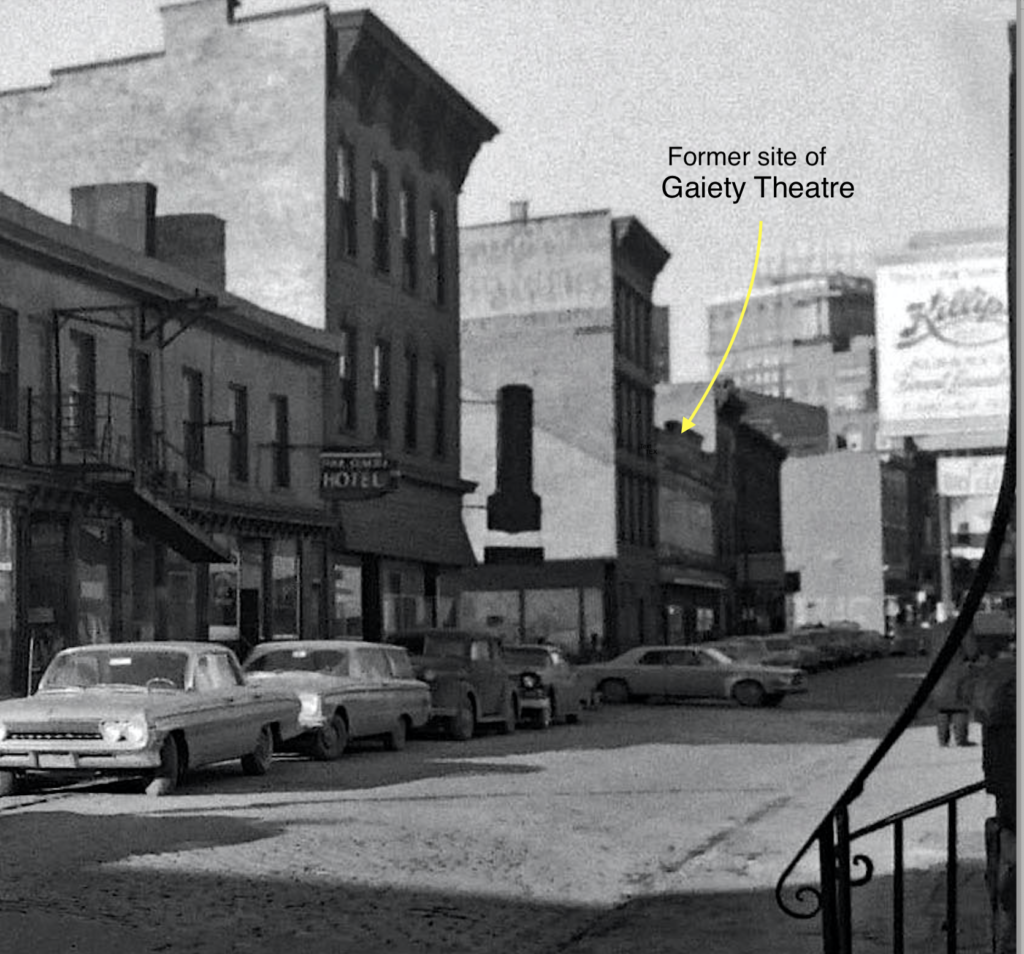
After that, there were any number of businesses that came and went, wholesaling and retailing out of the address, including several drug suppliers, Rheingold Salvage, We don’t have a definitive end date for the building that went up around 1915, but it likely was demolished as part of the South Mall expressway project in the early 1960s, and today the historic sites of Green Street, where for decades citizens came to see burlesque. are just rubble-strewn parking.

Leave a Reply